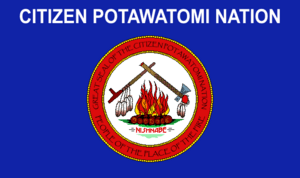Citizen Potawatomi Nation facts for kids

Flag
|
|
| Total population | |
|---|---|
| 37,264 | |
| Regions with significant populations | |
| Languages | |
| Potawatomi, English | |
| Religion | |
| Mide Religion or Medicine Lodge Religion, Native American Church, Christianity | |
| Related ethnic groups | |
| Council of Three Fires (Odawa, Potawatomi, and Ojibwe) |
The Citizen Potawatomi Nation is a Native American tribe officially recognized by the United States government. They are part of the larger Potawatomi people and are based in Oklahoma. The Potawatomi traditionally spoke an Algonquian language and lived in the Eastern Woodlands region. Today, the Citizen Potawatomi Nation has over 29,000 members, with more than 10,000 living in Oklahoma.
Contents
How the Nation Supports Itself
The Citizen Potawatomi Nation runs many businesses to help its people and community. These businesses create jobs and bring money into the tribe.
Businesses and Services
The Nation operates several types of businesses. These include a truck stop, two gas stations, and two smoke shops. They also have a bingo hall and two tribal casinos. For groceries, they run FireLake Discount Foods in Shawnee. If you like golf, there's the FireLake Golf Course. The Nation also owns First National Bank and Trust, with several locations in Oklahoma.
New Projects and Growth
The tribe's businesses have a big impact on the economy, bringing in hundreds of millions of dollars. In 2023, the Nation started a new company called Sovereign Pipe Technologies, LLC. This company makes special plastic pipes. It's the first business to open at the tribe's large industrial park, called Iron Horse. This park is close to a major highway and has access to the national train network, making it a great place for businesses.
Culture and Community Life
The Citizen Potawatomi Nation works hard to keep its culture alive and strong. They have special places and events that celebrate their heritage.
Cultural Center and Museum
In 2006, the tribe opened the Citizen Potawatomi Nation Museum and Cultural Heritage Center in Shawnee. This large building is a hub for learning and discovery. It holds the Nation's research library and historical records. You can also find a genealogy center to research family history. The center has a special Wall of Honor for veterans and spaces for exhibits and meetings. There's also a museum store where you can find unique items.
Annual Family Festival
While the tribe no longer holds its traditional intertribal powwow, they have a special event called the Citizen Potawatomi Nation's Family Reunion Festival. This festival happens every year on the last Saturday of June. It's a big gathering that brings together about 5,000 tribal members and their families. Over three days, people enjoy many cultural activities and other fun events. It's a time for families to connect and celebrate their shared heritage.
A Look at Potawatomi History
The history of the Citizen Potawatomi Nation involves many changes and moves. Their story shows the strength and resilience of the Potawatomi people.
Forced Relocation
The Citizen Potawatomi Nation comes from a group called the Mission Band of Potawatomi Indians. They originally lived in the Wabash River valley in Indiana. In the 1830s, the United States government passed the Indian Removal Act. This law forced many Native American tribes, including the Mission Band, to leave their homes. After the 1833 Treaty of Chicago, the Mission Band was forced to march to a new reserve in Kansas. This difficult journey is known as the Potawatomi Trail of Death. Out of 850 Potawatomi people, more than 40 died along the way.
Life in Kansas and New Beginnings
In Kansas, the Mission Band lived on a small reserve with the Prairie Band Potawatomi Nation. The Prairie Band had adopted some ways of the Plains Indians, but the Mission Band wanted to keep their traditional Woodlands culture. Because of these differences, the Mission Band leaders decided to try living on individual farms instead of sharing land with the Prairie Band. However, they didn't fully understand the tax system. Many of their new farms were soon lost to white settlers and traders.
To find a better future, in 1867, the Mission Potawatomi members signed a treaty. They sold their Kansas lands to buy new lands in Indian Territory, which is now Oklahoma. To protect their new land and learn from past experiences, tribal members chose to become U.S. citizens. From that time on, they became known as the Citizen Potawatomi.
Settling in Oklahoma
By the early 1870s, most Citizen Potawatomi had moved to Indian Territory, settling near what is now Shawnee. However, more challenges came. In 1890, the Citizen Potawatomi were again forced to accept individual land plots through the Dawes Act of 1887. This act aimed to break up tribal lands. In the Land Run of 1891, the rest of the Potawatomi reservation in Oklahoma was opened up to non-Native settlers. This meant that about 450 square miles of the reservation were given away by the government to new settlers.
Well-Known Citizen Potawatomi Members
Many talented people are members of the Citizen Potawatomi Nation. Here are a few:
- Woody Crumbo (1912–1989), a famous artist, flautist, and dancer.
- Mary Killman (born 1991), an Olympic synchronized swimmer.
- Robin Wall Kimmerer (born 1953), an environmental scientist, educator, and author.
- Tyler Bray (born 1991), an American football quarterback.
- Ron Baker (born 1993), a retired basketball player.
- Kellie Coffey (born 1971), a singer and songwriter who won an Academy of Country Music Award.
- Creed Humphrey (born 1999), an All-Pro center for the Kansas City Chiefs football team.
- Veronica Cortez (born 2004), who was crowned Miss Alaska for America 2023.

